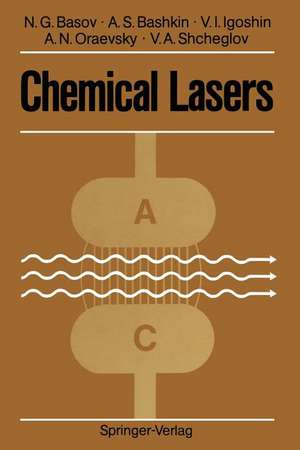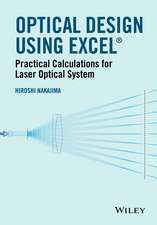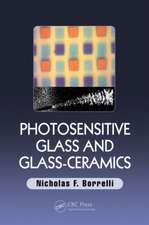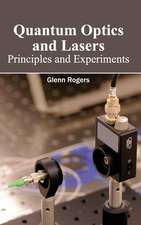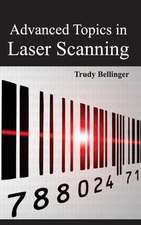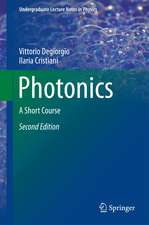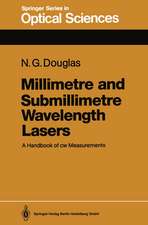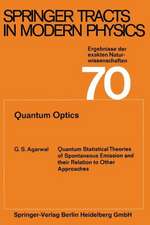Chemical Lasers
Autor Nikolay G. Basov Traducere de Sergei G. Kittell Autor Anatoly S. Bashkin, Valery I. Igoshin, Anatoly N. Oraevsky, Vladimir A. Shchegloven Limba Engleză Paperback – 21 dec 2011
Preț: 393.35 lei
Nou
Puncte Express: 590
Preț estimativ în valută:
75.29€ • 81.81$ • 63.29£
75.29€ • 81.81$ • 63.29£
Carte tipărită la comandă
Livrare economică 21 aprilie-05 mai
Preluare comenzi: 021 569.72.76
Specificații
ISBN-13: 9783642709630
ISBN-10: 364270963X
Pagini: 388
Ilustrații: X, 370 p.
Dimensiuni: 155 x 235 x 20 mm
Greutate: 0.54 kg
Ediția:1990
Editura: Springer Berlin, Heidelberg
Colecția Springer
Locul publicării:Berlin, Heidelberg, Germany
ISBN-10: 364270963X
Pagini: 388
Ilustrații: X, 370 p.
Dimensiuni: 155 x 235 x 20 mm
Greutate: 0.54 kg
Ediția:1990
Editura: Springer Berlin, Heidelberg
Colecția Springer
Locul publicării:Berlin, Heidelberg, Germany
Public țintă
ResearchCuprins
1. Introduction.- 2. Fundamentals of Chemical Laser Kinetics.- 2.1 Qualitative Analysis of Chemical Laser Operation.- 2.2 Nonequilibrium Excitation in Chemical Reactions.- 2.3 Population Inversion and Amplification of Radiation in Yibrational-Rotational Transitions.- 2.4 Elementary Vibrational Relaxation Processes.- 2.5 General Equations Describing Physico-Chemical.- Processes Occurring in the Laser Medium.- 2.6 Calculation of the Generation and Amplification of Radiation in Multi-Level Chemical Lasers in Quasistationary Approximation.- 3. Kinetics and Numerical Analysis of Chain-Reaction Chemical Lasers (Pulsed Mode).- 3.1 Brief Review of the Theory.- 3.2 H2-F2 System.- 3.3 D2 - F2 - CO2 System.- 4. Pulsed Chemical Lasers.- 4.1 Requirements for the Parameters of Chemically-Pumped Pulsed Laser Systems.- 4.2 Initiation of Pulsed Chemical Lasers.- 4.3 Laser Mixture Preparation Problems.- 4.4 Non-Chain-Reaction Pulsed Hydrogen-Fluoride Lasers..- 4.5 H2(D2)-F2 Lasers.- 4.6 D2 - F2 - CO2 Lasers.- 4.7 Effect of Additives Accelerating the Hydrogen Fluorination Chain Reaction.- 4.8 Beam Divergence in Hydrogen-Fluoride Lasers.- 4.9 Pulsed Chemical Lasers Operating on Vibrational Overtones of HF and DF Molecules.- 4.10 Amplifier-Mode Operation of Pulsed Hydrogen-Fluoride Lasers.- 4.11 High-Repetition-Rate Operation of Chemical Lasers.- 4.12 Pulsed Chemical Lasers Based on Chain Reactions Other than the Hydrogen-Fluorine Reaction.- 4.13 Current Status of Pulsed Chemical Lasers.- 5. Continuous-Wave Chemical Lasers.- 5.1 Physical Principles of Operation of CWCL’s.- 5.2 Purely Chemical Subsonic DF-CO2 Lasers.- 5.3 Supersonic HF (DF) Lasers..- A Review of Experimental Work.- 5.4 Principal Power Performance Features of Supersonic CWCL’s.- 5.5 Prospects for the Development of theDF-CO2 and HF CWCL’s.- 5.6 Other Types of CWCL’s.- 5.7 Other Possible CWCL’s Versions.- 6. Oxygen-Iodine Chemical Laser - a New Candidate for Engineering Applications.- 6.1 Experimental Results.- 6.2 Singlet Oxygen Generators.- 6.3 Kinetics of the Processes Occurring in the Active Medium of OICL.- 6.4 Pulsed OICUs.- 7. Photon Branching in Chain Reactions and IR-Radiation Initiated Chemical Lasers.- References.
